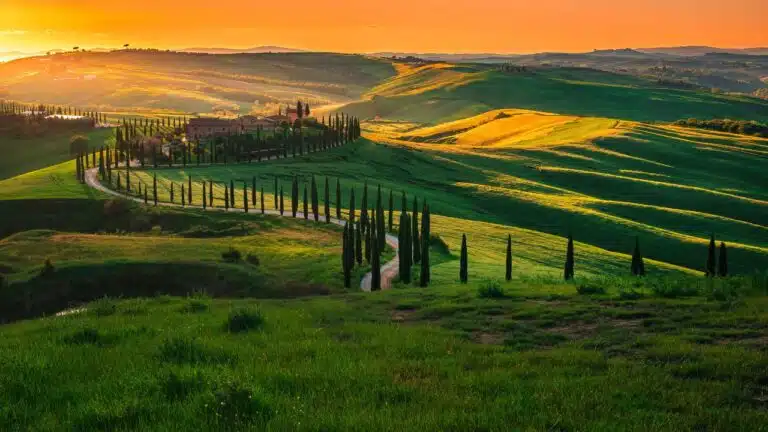Shoulder season. You’ve probably heard the term in passing or seen it mentioned on a travel blog as you scrolled through looking for destination ideas. But what is it? Why are travelers always talking about it? And does it live up to the hype? The shoulder season has definitely made a name for itself among the travel community. And if you’re curious to know what all the fuss is about, you’ve come to the right place. Here’s your quick guide to what shoulder season is and how you can utilize it to maximize your travel and, more importantly, your savings.
Table of Contents
- What Is Shoulder Season?
- 5 Reasons to Travel During Shoulder Season
- Are There Any Downsides to Traveling During the Shoulder Season?
- Double Your Savings with Next Vacay & Shoulder Season Travel
What Is Shoulder Season?
Shoulder season is the period that sits between a region’s peak and off seasons. The term was originally coined in the 60s, and speculation on where the name comes from varies. Some think it has to do with the shoulders on a bell curve and how they model the flow of tourists from peak to low seasons. Others believe it comes from the shawls people wore wrapped around their shoulders during the typical shoulder seasons of spring and fall. And some suspect that because peak periods were referred to as head seasons, it came about that the periods bordering that “head” should naturally be referred to as the shoulders.
While the reason behind the name of this key travel season remains elusive, one thing is certain. Shoulder season is the best time to travel to avoid high costs, big crowds, and all the hassle that comes with them.
When Is It?
Having established what it is, the next most important question is when it is. But similar to how it got its name, the answer to when shoulder season falls isn’t set in stone. Generally, travelers can look to the changing seasons for a reliable indicator of when they’ll find a region’s shoulder season.
Most European countries enjoy a shoulder season in the spring and fall, between summer vacations and winter holidays. But while Japan sees a similar peak in winter, it’s actually the spring and fall that draw in scores of tourists for cherry blossom festivals and fall foliage. This, in turn, pushes its shoulder seasons to the very edges of fall and spring.
Additionally, many regions now experience a short shoulder season in January, immediately following the end of the holidays. As tourists leave en masse, hotels and airlines drop their prices to entice travelers into taking a winter trip not dominated by holiday festivities.
5 Reasons to Travel During Shoulder Season
Shoulder season is often lauded as the perfect time to travel. Is there such a thing? We’d argue that the perfect time to travel comes in two types: whenever you get a deal and whenever you can get away. But suppose you consider perfection to be low prices, pleasant weather, and unforgettable experiences. In that case, the shoulder season comes pretty close. Here are five reasons to plan your future travels for this time.
1. Score Lower Prices
It’s not just your imagination. Travel costs are more expensive than ever, and 2024 is set to be no different. In truth, paying peak season prices has never looked less appealing. But there’s an easy fix to battling the skyrocketing cost of travel: going against the crowd. Findings from a 2021 NerdWallet analysis found that airfare was 23 percent cheaper during shoulder season than peak season. That can translate to hundreds of dollars in savings. The analysis also found that the best time to travel was just after a holiday when travelers could score an average of 50 percent savings.
And if you’re thinking that’s just airfare, the same holds true for accommodations. Data collected by Hotels.com found that the best time to book cheap hotel rooms was just after the holidays in what many now call the cold shoulder season.
2. Enjoy Idyllic Weather
The shoulder season is known for its mild manner. You won’t find the oppressive heat of summer or the heavy chill of winter here. Because it typically falls around the changing of the seasons, travelers who opt to vacation during this time are treated to a hybrid weather, with largely sunny days and pleasant temperatures.
In some places, shoulder season weather is even better than peak season. While summer in the Grand Canyon might lead to hallucinations from the heat, the breezy air of spring and fall will keep your hikes pleasant, and you’ll find yourself smiling for more than just a sweaty photo at the end of your journey.
3. Shake off the Peak Season Crowds
More people are looking to travel than ever before. That means more people everywhere you go. And it’s particularly obvious when you travel during peak season. Beaches are crowded, accommodations are full, and lines stretch out the door for popular attractions.
In comparison, shoulder season promises a reprieve from the crushing crowds of summer vacation and the winter holidays. The scores of tourists lessen, and you get to experience more of the local culture and people. As an added bonus, going when fewer people go means avoiding all the competition that comes with peak season. So you have better odds of getting in to see attractions, eating at popular restaurants, and so much more.
4. Avoid Off-Season Closures
Just as peak season sees incredibly high highs, the low season can experience lows so low that some places become near ghost towns in the absence of tourists. And while having a town to yourself may sound great in theory, the reality is that many places shut down for the low season. So rather than having to vie for a way in the door, as the peak-season crowds do, the off-season crowds may find the door closed in their faces.
National parks shut down trails, popular restaurants close up shop, and coveted attractions have reduced hours or stop operations entirely. The weather in some spots may swoop in to rain on your parade, quite literally in hurricane-heavy spots like Florida. And while you might have scored a deal on your hotel, you may find yourself coming up against renovations that take away from the relaxing experience you’re looking for.
But for those who elect to travel during the shoulder season, it’s a much less challenging experience. This period of time may see a few rainy days, but nothing like the torrential downpours or closures of the off season. Shops and restaurants are open for business, and it’s the perfect time to see attractions that are either gearing up for the peak season crowds or winding down from them.
5. Experience Unique Local Events
Tourist destinations want year-round crowds. One way they get them is by holding fun festivals and events when tourists aren’t as likely to drop by, like the Hawaii Food & Wine Festival or the Bowen’s Wharf Seafood Food Festival in Newport. Both of these events take place in October, after the peak season crowds have departed, and are another fun perk of traveling in the shoulder season.
International destinations also sport exciting festivals, though they aren’t necessarily catered toward drawing in crowds. Instead, many show off cultural traditions steeped in history and local mythology, from Loy Krathong, Thailand’s Festival of Lights in November, to the Mifune Boat Festival, Kyoto’s annual procession of traditional boats held in late May.
Whatever the origin behind these festivals, they provide something fun and different for off-the-beaten-path travelers to experience when planning their shoulder season trips.
Are There Any Downsides to Traveling During the Shoulder Season?
While every travel season has its downsides, the shoulder season has fewer than most. However, there is one glaring factor to consider: Depending on the type of vacation you want, the shoulder season could be the worst time to go. If your goal is to experience the midnight sun in Iceland or shred the snowy slopes of Colorado’s Rockies, the shoulder season won’t cut it, and you’ll have to make peace with planning your trip during specific and popular times of the year. But for some, the added crowds and higher prices may be worth these coveted experiences.
As for keeping your travels centered around the shoulder season, the bottom line is this: If your schedule is flexible enough to travel during the shoulder season, then do. From more savings to unique cultural experiences, travel in the shoulder season is one of the richest and most rewarding travel experiences you can have.
Double Your Savings with Next Vacay & Shoulder Season Travel
Ready to take your next trip to the max? Pair your shoulder season travel with a deal from Next Vacay to double your savings and maximize your experiences. Next Vacay helps you keep your travel flexible and affordable, with deals to hot destinations all throughout the year. Our team of deal hunters spends every minute of every day hunting for the best of the best to save you hundreds of dollars on your flights.
Plan your trip for the cost-saving shoulder season with money-saving flight deals and shave off even more expenses with the deals you’ll score on location. With flights delivered right to your inbox, you’ll never miss an opportunity to save or get away again. It’s time to become a shoulder season traveler … it’s time for your Next Vacay.



